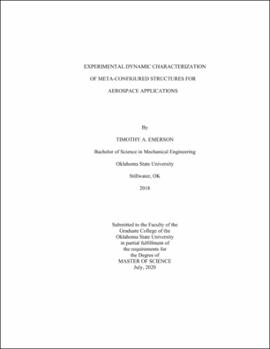| dc.contributor.advisor | Manimala, James | |
| dc.contributor.author | Emerson, Timothy A. | |
| dc.date.accessioned | 2021-02-22T22:41:11Z | |
| dc.date.available | 2021-02-22T22:41:11Z | |
| dc.date.issued | 2020-07 | |
| dc.identifier.uri | https://hdl.handle.net/11244/328644 | |
| dc.description.abstract | Drawing inspiration from acoustic metamaterials, meta-configuration as a means to improve coactive mechanisms between sub-structures to enhance overall structural performance is investigated with a primary focus on aerospace applications. Two prototypical meta-configured structures for dynamic load manipulation were designed, constructed and experimentally characterized. The first of these is a directional wave guide (DWG) that utilizes tailored spatio-spectral band gap regions to selectively attenuate or propagate frequency components within tunable bandwidths along designated paths. Finite element simulations were performed to evaluate designs for various resonator sub-structures and their patterning within a plate-type wave guide. Relative band structures for the resonators were tuned to span a frequency range from 16 to 20 kHz. The DWG is fabricated by chemically etching a patterned array of cantilever beam-type resonators on a 50-micron thick brass sheet. A custom test-rig consisting of an adjustable mount with low-stiffness boundary, piezo-actuator and a mechanically-staged laser vibrometer was used to conduct the experiments. Overall, reasonable correlation is indicated for the designed versus measured extents for the band gap frequency ranges along each path, although further detuning of global modes and minimization of resonator and boundary variability would help improve correlation. The second prototypical structure investigated is a passive-adaptive tuned vibration absorber (TVA). In contrast to conventional TVAs which are tuned to absorb vibrations within a preset bandwidth, the passive-adaptive TVA would be able to self-tune based solely on the input excitation to deliver appreciable absorption spanning larger bandwidths. An approach based on a riding mass retained under spring force on a cantilever beam resonator is explored for a low-frequency (~40-80 Hz) passive-adaptive TVA. Test articles with various configurations for the riding mass attachment were constructed and dynamically characterized using non-contact transduction techniques. An increase of about 55% over the mass-equivalent, conventional TVA's absorption bandwidth is obtained for the passive-adaptive TVA without altering its lower bound. These results indicate that meta-configured structures may provide improved solutions in applications such as isolation of payloads from structure-borne vibrations having a meandering dominant frequency content. | |
| dc.format | application/pdf | |
| dc.language | en_US | |
| dc.rights | Copyright is held by the author who has granted the Oklahoma State University Library the non-exclusive right to share this material in its institutional repository. Contact Digital Library Services at lib-dls@okstate.edu or 405-744-9161 for the permission policy on the use, reproduction or distribution of this material. | |
| dc.title | Experimental dynamic characterization of meta-configured structures for aerospace applications | |
| dc.contributor.committeeMember | Kidd, James | |
| dc.contributor.committeeMember | Xiang, Yujiang | |
| osu.filename | Emerson_okstate_0664M_16816.pdf | |
| osu.accesstype | Open Access | |
| dc.type.genre | Thesis | |
| dc.type.material | Text | |
| dc.subject.keywords | band gap | |
| dc.subject.keywords | bandwidth | |
| dc.subject.keywords | meta-configured | |
| dc.subject.keywords | passive-adaptive | |
| dc.subject.keywords | tuned vibration absorbers | |
| dc.subject.keywords | wave guide | |
| thesis.degree.discipline | Mechanical and Aerospace Engineering | |
| thesis.degree.grantor | Oklahoma State University | |
